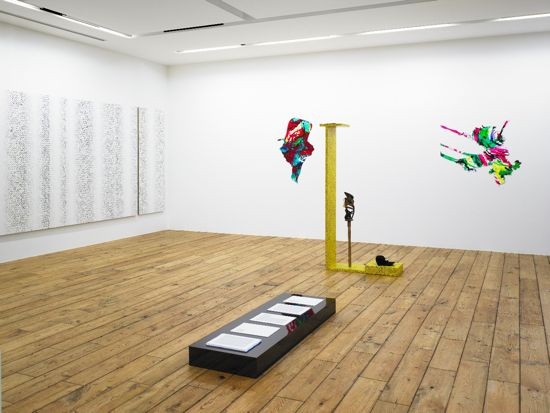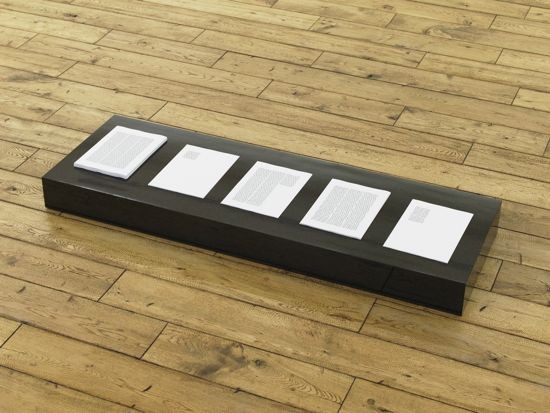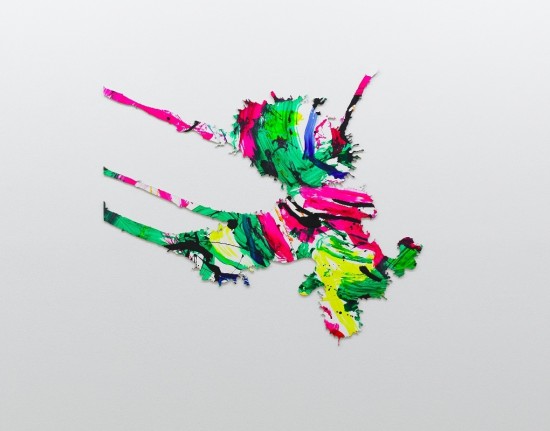II. The Index of Robert Macaire
Cheyney Thompson on the technology of perspective, and names that un-name.
 Installation view of the solo exhibition “Chronochromes, Data, Motifs” at Rat Hole Gallery, Tokyo, 2011. All images: Courtesy Cheyney Thompson and Rat Hole Gallery.
Installation view of the solo exhibition “Chronochromes, Data, Motifs” at Rat Hole Gallery, Tokyo, 2011. All images: Courtesy Cheyney Thompson and Rat Hole Gallery.ART iT: We were just talking about the metaphorical role of perspective in the capitalist organization of life. Who knows what the nature of the market or the nature of consumption will be in the coming years, but with so much of society and its functions shifting to the Internet, it’s like we’ve reached an atmosphere of pure consumption in which we’re no longer aware of our consuming. Almost all the content online is free, and yet it’s all being traded on in some way.
CT: A friend of mine says that it’s capitalism’s final frontier to colonize the unconscious, where the screen of fantasy is literalized in the digital screen. With the Internet, the potential for capital is almost worth more than capital itself. That’s why Facebook doesn’t go public. The longer they withhold, the more the speculations of how they could be marketable proliferate – infinitely perhaps – because you have a massive data set that tells you how people think, what their life rhythms are, how they communicate with each other, how they express themselves. That’s worth a lot of money. And because people always find new ways to use the technology, there are even more potential ways for it to be translated into capital.
But it isn’t completely free. There are massive infrastructures behind everything. Those are real people working at Foxconn Technology Group in China, and real people’s lives that make this stuff that then does something else that’s free, so there’s certainly material that necessarily makes the whole thing work, and that material is only functional because of a certain amount of labor that goes into shaping it. But that is the tricky thing about thinking about technology, in that technology is both the result of material forces – institutions, research, labor, papers, manufacturing the material world – but it also results in the creation of a tool, and then that tool changes us because we’ll find novel uses for it that may or may not be material. I think it’s important to always see both sides of how technology is functioning.
ART iT: Does that parallel your working process? Is each new project, to borrow an industrial term, something like research and development? Is that what happens with the labor that goes into producing a “Chronochrome” painting?
CT: I do think a lot about technology and histories of technology in the work, and I even think of painting itself as a kind of technology. That seemed to be the only way to get beyond what we started off discussing – these geopolitical histories of a given material culture whereby you have a lineage of painting that originates in the Renaissance, is refined throughout the 19th century in France and then attains a sort of quasi-universal status as Modernism proper. That’s a narrative, but if we think of it as a technological form that relates to but is not limited to seeing, relates to but is not limited to architecture, relates to but is not limited to theatre – which is where I think painting on canvas originates, in the production of portable sets or backdrops – that resembles a technology that has updated itself over time. Somehow that’s a more interesting way of thinking the history of painting, because it allows more mobility. That’s what I did in college when I studied Islamic art history. I wanted to look at the history of Persian miniature painting in order to understand the way that form developed in relation to a page and in relation to text, not so that it could be integrated into a master narrative of painting, but rather to see it as a development in the technology of painting.
ART iT: But if we look at art or, specifically, painting as a technology, what does that do to the idea of cultural relativism? The “Chronochromes” may be tongue-in-cheek, but they develop from a carefully thought-out algorithm, as opposed to the average figurative life study. Doesn’t that bring us back to the whole colonial project that considered technology to be objective?
CT: Probably. It’s a problem I ran into when I tried to write on perspective for my final paper in the Islamic art history course. The mathematical, theoretical foundations for perspective come from the 11th-century Islamic philosopher Alhazen (965-c1040). My question going into the paper was, why didn’t perspectival representation develop in Persian image making when the theoretical foundation was already there? But then most of the paper was spent debating with myself: well, why should it? Just because there’s a theoretical description of how light enters the eye doesn’t mean that there should be images that are created that offer proof of that description of an optical phenomenon. I was certainly aware of a kind of colonialist bias in the formulation of the question in assuming the technology of perspective could be an objective truth.
ART iT: I may be misremembering, but I’m pretty sure the Chinese were also aware of perspective and simply chose to reject it as a form of expression – even if it’s not true, it’s conceivable.
CT: No, it is true. This is a debated contention, but it’s most likely that the Persian miniature tradition came from Chinese and Indian painting, so if you move along that axis you see remarkable similarities in some respects. It was so long ago when I was writing the paper, maybe in 1995 or ’96, but I do remember seeing examples of work from 16th- or 17th-century India that incorporated perspective in a certain way. In that case, perspective could have been simply a diminishing scale of an object in space, rather than a more typical ordering in which what’s far away is higher on the page and what’s closer is lower on the page. But ultimately there weren’t that many examples of fleshed-out perspectival space. The exception that really interested me was perspective in Pompeiian and in Islamic frescoes, which were used as a kind of scenography, like stage painting. There are numerous examples of perspective in these traditions, in that they involved a trompe-l’œil situation of extending space by repeated, diminishing, organized architectural motifs in space, and that certainly existed before the whole incorporation of perspective in the West.
ART iT: In China’s long tradition of ink painting, there was also an intellectual rejection of the professional artist, a distinction between artist and artisan, or expression and craft. The intelligentsia did not think of themselves as commercial artists, and now of course the same thing is playing out all over again now with contemporary artists choosing to either enter the commercial system or reject it. Perhaps going forward there will be no escape from the market, but at least up to now that choice has been an option.
CT: I think that still exists. “Market” itself is a tough word, and one that I try not to use so much anymore. The typical press release line about my work is that I am an artist who investigates the work of art in the market place. I have a much harder time now describing what I am doing that way. I don’t even know where that came from as a description of my work.
Obviously we can and have talked about the market and I think about it, but that’s maybe why I shifted to thinking about technology, identity and subject-object relations as a way of describing things – and even affect, bodies – terms that are more formal in some respects and thus more general but also I feel more accurate. The market itself is just a simple form. Traditionally it was the more or less rectilinear space set up in a village that organized a set of goods. It was that place where objects were taken out of use and put into potential circulation. It seems like we know what we’re talking about when we talk about the art market, but we could be talking about any number of things.
 Pedestal XXI (2011), formica and wood, 12.7 x 50.8 x 152.4 cm.
Pedestal XXI (2011), formica and wood, 12.7 x 50.8 x 152.4 cm.ART iT: That’s what I find challenging and provocative about works of yours like Quelques Aspects de l’Art Bourgeois: La Non-Intervention (2006). The circulation of art is a mess. You can’t escape the objectness of the artwork; you can’t escape the distribution of the artwork through means of exchange, but very few artists try to make art about that mess. They ignore it or suppress it.
CT: Sure. I think there are formal and material reasons for my concerns, and also perhaps a politics could emerge from those forms and those materials in that I think things like showing, display or reading versus seeing; writing versus mark-making; the expressive versus the technical; what you describe as the artisan-artist split – all those things together are what constitute the work of art, and in a way you can keep adding to the list, and often the terms themselves overlap with other terms. I think as an artist simply that’s all I’m doing, is trying to think those terms while working.
ART iT: Your recent exhibitions have had titles that in Internet terms might be understood as lists of keywords, and these keywords then reappear in critical texts about your work. If you’re not interested in talking about the market, then at least you seem interested in exploring performances of redistribution.
CT: Yes – on a symbolic economy. That’s the thing that gets tricky talking about a market. There are so many ways you could describe it. You could do a formal description where it’s just an area in space where things are taken out of use, or you could do a strict Marxist account of the transformation of material via labor, necessary labor time, and so on, but then there’s also economies that operate in language and meaning that weirdly, again, overlap with what we would think of as real material economies.
Why gold? Paper money itself as a substitute works a lot like the way the signifier substitutes for the signified. When all that’s technologized and rendered as flows of electricity, the speed at which names, ideas and meaning effects are put into circulation is very unstable. It’s also kind of amazing. As you said before, I like reading about people on Wikipedia, I like access to free information, I like being able to search 100 years’ worth of academic journals for given keywords – definitely – and that consolidates new types of knowledge.
I’ve seen it happen in music. The kind of music I make, and that I’m into, is called Minimal Synth, a made-up genre for basically all of the most minor industrial synth groups of the 1980s, which originally only existed as cassettes and 7-inches and then gradually as those things were translated to information was allowed to proliferate. The term for the genre actually came from E-Bay, at a time before a lot of music was digitized and you still had to buy it, and now there’s a small economy of Minimal Synth. There are record labels specializing in it, there are special nights in New York for the music. That’s a very unusual thing. It’s of history but it’s something new that couldn’t have happened without the rapid exchange of information between people.
ART iT: How willfully do you think of your exhibitions as a platform for redistributing keywords?
CT: It’s something else I’m ambivalent about, which is mostly apparent in the pedestal works because it’s like a question of quantity and quality. An early ARPANET project was digitizing the Greek literature canon in the original Greek. Every word was hyperlinked to a history of its usage, where it occurs in every text so in a way the entire text would be all keywords – amazing! You would hope that those keywords would produce a synthetic form of knowledge whereby they cohered into a new object of knowledge. In other words, I wouldn’t want to put into circulation a bunch of random terms that don’t mean anything, and yet I always feel that’s exactly what’s happening. So the pedestals on the one hand mark a place where those words cohere into a particular form – an academic text, an artifact, whatever it happens to be that stands as a speculative form of the keyword, but it very well could be something else. I feel like there’s some kind of missing part that I really don’t know how to do, which would be to make those things cohere into a representative form – rather than a speculative form – that made manifest the knowledge that the keyword points to. That’s for a future work; it’s not a resolved problem, and I’m fine with it not being resolved. Just having access to everything doesn’t mean we know how to use it.
Although I think instead of keyword I prefer the term “naming.”
 Motif XV (2011), watercolor and gouache on paper mounted on laser-cut aluminum, 76.2 x 101.6 cm.
Motif XV (2011), watercolor and gouache on paper mounted on laser-cut aluminum, 76.2 x 101.6 cm.ART iT: As in your use of the name Robert Macaire?
CT: Yes, exactly. That’s a name that’s been put into circulation. I think one statement that made it into a press release was “the name that un-names.” But the Munsell color system itself was born out of Munsell’s frustration with the subjectivity of naming color – Venetian Red versus Iron Red and all the reaching, adjectival descriptions of color phenomena. Munsell said, no, we can systematize how we describe color, and introduced numbers into the description of color, which allowed him to see and conceptualize relations between colors that language couldn’t accommodate. It wasn’t perfect, but it was a really adequate system, and it was the precursor of digital color specifications.
That problem of naming has long interested me, because painting itself is a proper name, painter is a name. I like the idea that saying a name of some kind is also a kind of birdsong or animal sound. It’s both a call, and a designation or imposition of an identity, as with Althusser’s illustration of interpellation in which if a cop on the street calls out “Hey!” and you turn your head, you’re implicated. I like trying to think of naming in a way such that the name “painting” doesn’t necessarily have to mean the histories that we’ve been talking about that are particular to a given region or time or language. Instead, painting could be “that” – it is that thing or identity, but it’s also just an utterance, a call of some kind of pure potential that’s either answered or not. Either the code finds its receiver or translator, or it doesn’t.
I. The Strangeness of Discipline
Cheyney Thompson: Allegory of the Body and the Name
